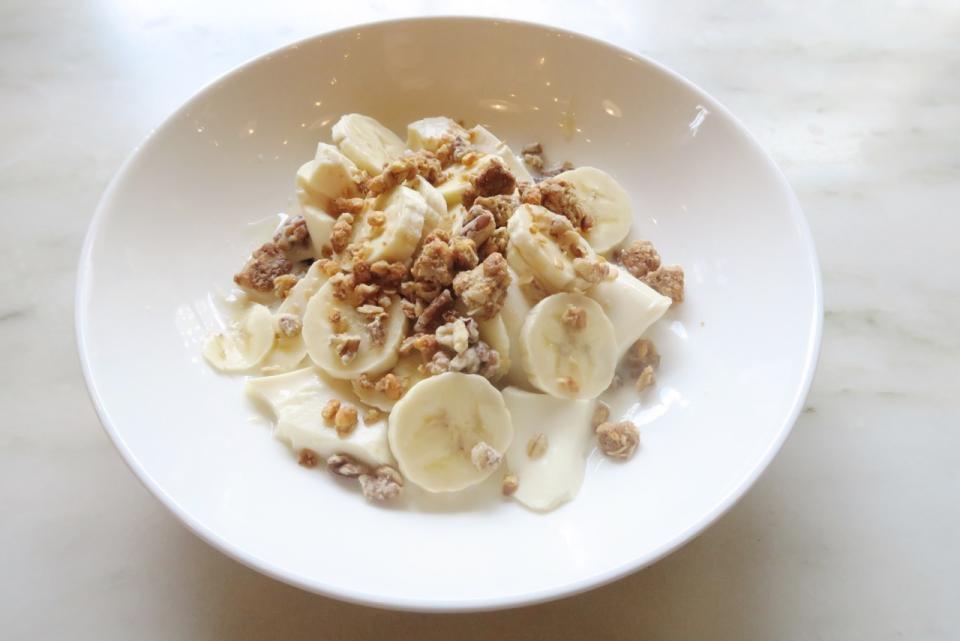What We Can Learn From the Way the Japanese Eat Breakfast

Japanese breakfast is a study in eating the rainbow.
Last year, I paid a visit to ramen whisperer Ivan Orkin’s Ivan Ramen Slurp Shop at Gotham West Market to find out more about the late-night ramen phenomenon sweeping the states. His handmade noodles and rich broth are deservedly touted as some of the city’s best—in fact, he has a reputation as one of the top ramen chefs in Japan (pretty amazing for a Jewish guy from New York)—so when our team found out he was adding breakfast to the menu of ramen and rice bowls, we knew we had to check it out. As on my first visit, we ordered basically everything on the menu—bacon-and-egg buns with yuzu hollandaise; silken tofu with condensed milk, bananas, and a pecan-oat crumble; and broiled salmon, miso soup, and white rice topped with poached egg and pickles. As one does when one orders the full spread, we happily shared with our neighbors, including writer Jessica Chou. She impressed us with her noodle twirling skills and also let us try her 8AM ramen, a soupy, umami-enhanced mac-and-cheese-like dish that had everyone raving. It seemed natural to ask her to delve a bit deeper into the world of natto and tamagoyaki; here is what she found out.

Jessica Chou digs into Ivan Orkin’s 8 a.m. ramen at the Slurp Shop at Gotham West Market.
Sophisticated, colorful, and elaborate, Japanese breakfasts are typically composed of four or five components—or even more. Known as choshoku or “first meal of the day,” it wouldn’t be unusual for breakfast to included griddled salmon, miso soup, pickles, natto (fermented soy beans) with rice and raw egg, tamagoyaki (grilled eggs), and Japanese sausage. “Breakfast is a very sentimental meal in Japan, even in Tokyo,” Momoko Nakamura, a food business consultant in Tokyo, explains. “It’s taken more seriously than Americans take their breakfast; once you start your day it’s ‘Go go go,’ so breakfast is the 30 minutes where you can sit down with your family and eat before the day starts.”
Want More Giada? Subscribe to Giada Weekly!

The seriously traditional Japanese breakfast with natto and salmon tartare.
Japanese breakfast also tends to be a more savory affair than the American version. “In the West, breakfast usually means something gentle, often sweet, or made with eggs. But I don’t think people are bound to the western notion of that in Japan,” Orkin says. “Some people have noodles for breakfast. My go-to breakfast is a plate of curry rice with a fried egg on top and sausage, but it depends on what I have in my refrigerator. Right now, I have a pint of salmon eggs. I was doing some R&D for a new menu, so, for breakfast, I had a bowl of rice with salmon eggs and soy sauce on top.”

Perhaps there’s something we can learn from the way they eat in the mornings in Japan. Dissect any breakfast spread and you’ll see that each dish serves a purpose, following the notion of balance within traditional kaiseki, or multicourse, meals. Fish and egg serve as healthy proteins; Japanese pickles (tsukemono) provide gut-friendly bacteria; miso soup is packed with antioxidants. Natto, rich with vitamin K2, is great for bones and heart health, while a mandatory fruit or salad component takes care of fiber and other great nutrients. “The meal tends to be lighter than American breakfasts, but it has the same amount of protein, and the flavors are super clean,” Orkin says. “There’s nothing much better than that.”
Related: DIY Tofu
Indeed, the name of the game here is health, codified through a variety of dishes and colors. “More colors mean more vitamins,” Nakamura says. “No way would your mother allow you to just have cereal for breakfast.” Of course, for some—particularly young 20-somethings living alone for the first time—an elaborate breakfast might have fallen by the wayside. Still, Nakamura says, “I don’t think breakfast will ever be lost. It really is the perfect platform to capture the Japanese concern for aesthetics, health, and family, all in one pretty little picture.”
Of course, international exports to Tokyo like Australia’s Bills or NYC’s Clinton Street Baking Company have inspired Tokyo millennials to brunch, Orkin notes. As he travels back and forth between Tokyo and New York, he’s found that modern Japanese breakfasts are often an amalgamation of Western and Japanese influences—as at his Ivan Ramen Slurp Shop.
“We have things that are really traditional, like salmon and pickles and rice. We have porridge, but we also have buckwheat pancakes as a nod to America,” Orkin says. One of his dishes, a sweet tofu dish with condensed milk, granola, and bananas (think of it as a yogurt parfait), is a perfect example of the melding of cultures.

GiadaWeekly is the digital food and lifestyle magazine from cookbook author and Food Network star Giada De Laurentiis. To get a new issue each Thursday, download the app or subscribe at www.giadaweekly.com. And follow GiadaWeekly on Instagram and Facebook.

